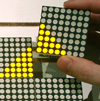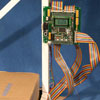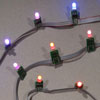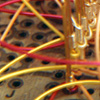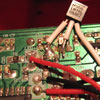Everybody asks that. Figuring out what happened wasn’t easy.
Suspect #1 – The Intercom
Immediately after the fire, the firemen pulled out this item from where the fire took place, and casually suspected it as the cause:
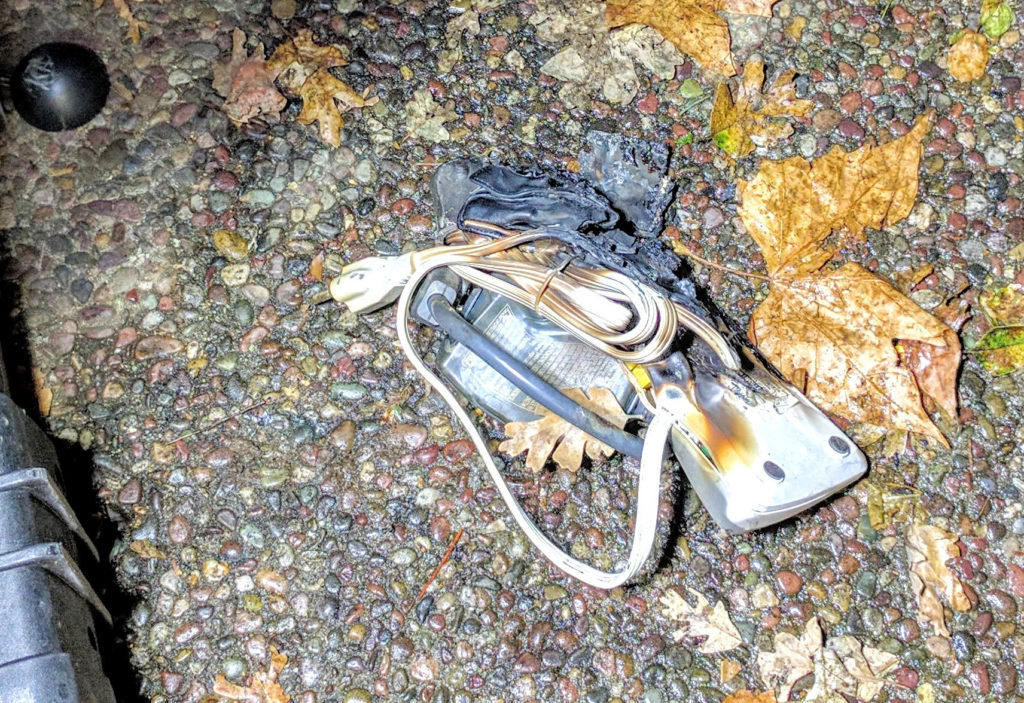
It’s a home intercom unit. It’s designed to use the house’s power wiring to communicate. They’d never worked all that well, and several months before we threw out two of the three units. I had an idea for an improved design, so I kept the remaining unit thinking I could re-use the plastic case and put my own workings in it.
We thought the intercom had been left plugged in, fell the the floor, and eventually failed somehow. For a while, I convinced myself the powerline circuitry had shorted through to the much more delicate audio circuits, causing a fire.
But things about this theory bothered me. First, space on my desk was scarce, so when I removed it I would also want to free up a space on the power strip it was plugged into. Second, the cord was wrapped up. If I’d left it plugged in after it fell of my desk, most of the cord would be unwrapped. Third, if I was just saving it for parts, I wouldn’t leave it plugged in.
Still, for a few days, this was the only clue we had.
Suspect #2 – The Power Strip
Several days after the fire, this appeared outside on the one of the drawers the firemen removed from the burned cabinet.
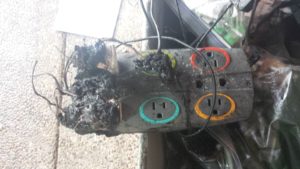

This power strip wasn’t there immediately after the fire, so I can only guess somebody on the restoration crew found it and placed it there. It held several power adapters, a few running Raspberry Pi computers, LED desk lamps, my Hypnocube, a charger for my phone. The whole strip was easily using less than 60 watts. Nearly a quarter of the power strip is melted away. It was clearly part of the plastic volcano smothering my office in soot.
From here, it’s difficult to discern what happened. The insulation on some of the wires coming out of the power adapters is completely burned away. But the adapters, if properly designed, should simply shut down if something is shorted.
A frequent question immediately after the fire was: how could something electronic suddenly just fail? After all, if there’s no moving parts why should something wear out?
But actually, a lot of electronic items do have subtle moving parts: coils of wire called inductors or transformers. You might remember the grade-school science experiment of wrapping a coil of wire around a nail. Connect the ends of the coil to a battery, and the nail the coil is wrapped around becomes an electromagnet, attracting metal objects nearby.
Even without the nail in the middle, coils can vibrate when electrons are sloshing back and forth in them. When you hear electronic gadgets whine or buzz, it’s the inductors. Here’s an example of an inductor-caused failure in a lamp dimmer:
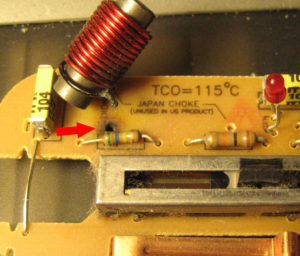
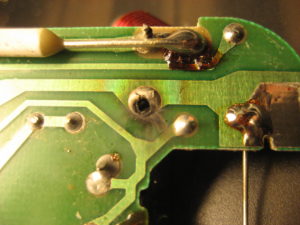
In the first photo, I’ve pulled the coil aside so you see the burned area of the circuit board. The motion of the coil cracked the solder joint (next photo) causing it to start sparking. The heat from the sparks burned the circuit board, but once enough of it burned, the electric circuit was broken, and the dimmer simply stopped working.
Of course, moving inductors aren’t the only way electronics can suddenly fail. Another cause is a phenomena known as thermal runaway. In this case, a component may perform some function such as regulating the amount of electric current a circuit uses. If the component is improperly manufactured, it may pass slightly more current that it’s supposed to. This causes the part to get warm. Over time, this increase in heat causes it to pass yet more current, which makes it even warmer. This situation – the component getting warmer, passing more current, then getting hotter, continues until it takes off exponentially. Finally, something more drastic fails, like a fuse blowing…or a fire starting.
Here’s a scarier example:
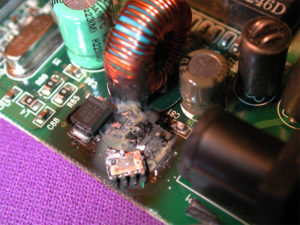
This is a Hawking five port Ethernet switch we had mounted on our attic wall. It failed after several months of use. I noticed a distinct burned electronics smell going upstairs to see why our home network was no longer working. Opening the switch up, I found one of the chips (burned beyond recognition) had melted itself off the printed circuit board. Fortunately the switch was mounted vertically on the wall, so when the chip got hot enough to melt the solder attaching it to the circuit board it fell away, breaking the circuit. Had it been mounted horizontally, it may have caused more serious damage.
So, back to the power strip and the wall adapters plugged into it. Could one of them spontaneously fail, causing a fire? It’s possible. Ken Shirriff has written some fascinating articles about safety and power adapters. In particular, he shows how the careful safety measures in an expensive Apple power adapter (iPhone, MacBook) are left out in cheap knock-off versions. Highly recommended reading if you want to understand what’s going on (and what should not be going on) inside those ubiquitous wall warts.
While thermal runaway or inductor arcing may start a device failure, they’re much less likely to sustain it. Like the two examples above, something usually “gives”, and the device fails completely rather than burning for any length of time. Circuit boards and electronic components aren’t particularly flammable on their own. Unless it catches something nearby on fire, most electronic devices aren’t themselves flammable enough to start and sustain a serious blaze. This was a problem with the failed wall wart theory.
Suspect #3 – The Starter Battery
My son and I were driving to his school in the morning a few weeks after the fire. Learning to drive, he has a renewed interest in cars. At one point, he asked about how jump starting a car works.
Ding!
That conversation jogged my memory. I’d been cleaning out my office, and found an “iJump Ultra-Compact Car Jump Starter”. This was a power bank, about half the size of a paperback book. Once charged, you plugged it directly into jumper cables to jump start a car. The battery, however, needed to be charged every several months to ensure it would have enough juice to start your car. Since I hadn’t used it in several months, I had plugged it in to recharge it the day of the fire.
Exploding batteries are in the news. From the infamous Samsung Galaxy Note 7, to the cheap “hoverboard” scooters, poorly designed batteries are catching fire. Modern lithium batteries pack a lot of energy in a small space. Release all that energy at once, and you have an explosion and fire. Worse, the electrolyte – the chemical used to create the electric current in lithium batteries – is seriously flammable, and sustains the blaze. If an electrical failure in the battery or surrounding electronics gets hot enough to ignite it, the electrolyte causes a substantial fire on its own.
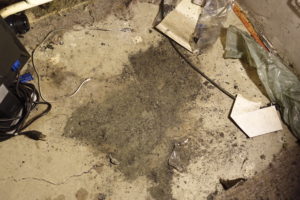
Unfortunately, there was nothing left of the battery to prove it was the culprit, but the circumstantial evidence for it is strong.
The lesson is when it comes to gadgets with dangerous components: Corporate reputation means something. The Samsung Note 7 battery failure became international news, forcing Samsung to bend over backwards to repair the damage and preserve confidence in their brand. They not only exchanged the suspect phones for another model, but supplied fireproof boxes for doing so. They brought in well-known experts to research the failure and clearly identify the cause.
By contrast, “iJump” doesn’t appear to exist anymore, no doubt quietly shutting down after their products failed in the field (hopefully with less damage). But nothing stops them from printing a new batch of labels and dumping the product on more unsuspecting customers through Ebay and Amazon under another generic brand. And nothing stops them from cutting corners on safety mechanisms to keep the batteries from starting more fires.
Thanks to Ken Shirriff for comments on an earlier draft.














